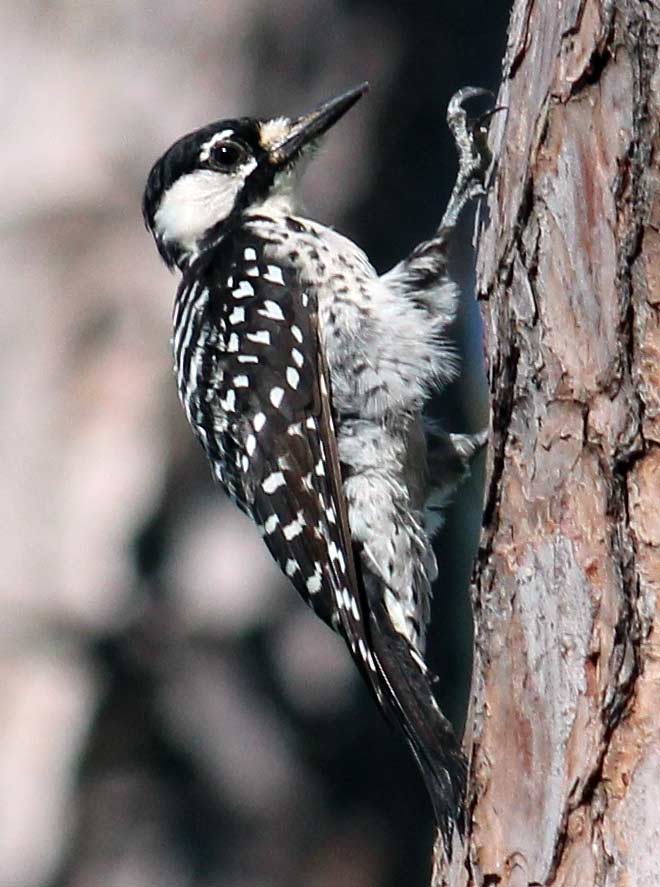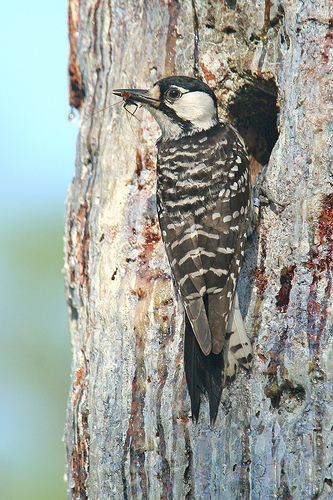
Picoides borealis
SUBFAMILY
Picinae
TAXONOMY
Picus borealis Vieillot, 1807, North America (specific locality
unknown, but arbitrarily decided to be Mount Pleasant, South
Carolina). Two subspecies described, Picoides borealis borealis
from most of the species range, and P. b. hylonomus from central
and southern Florida. Researchers have discounted the latter
race in the late twentieth century.
OTHER COMMON NAMES
French: Pic boreal; German: Kokardenspecht; Spanish: Carpintero
de Cresta Roja.
PHYSICAL CHARACTERISTICS
About 8.7 in (22 cm); 1.4–1.9 oz (40–55 g). Medium blackand-
white woodpecker; primary distinguishing characteristics
include large white cheek patches with ladder back; males have
several tiny red feathers between white cheek patch and black
crown, but the red is usually concealed; females lack the red;
immature males may have irregular red patch on forehead, immature
females tend to have white flecks on lower forehead.
DISTRIBUTION
Southeastern Oklahoma and eastern Texas, southern Missouri,
south central Kentucky, central Tennessee, to southeastern
Maryland, south to southern Florida and across the Gulf coast.
Now extirpated from Missouri, Kentucky, Tennessee, and
Maryland. Vagrants have shown up as far north as Illinois and
New Jersey.
HABITAT
Extensive, open, old-growth pine forest, naturally maintained
by lightning-started fires.
BEHAVIOR
The red-cockaded woodpecker is a very social species that lives
in extended family groups including one breeding pair, their
offspring from recent nesting efforts, and males from earlier
nesting efforts. The group forages over an area averaging
about 200 acres (80 ha) in good habitat and more than 1,000
acres (400 ha) in poor habitat. Cavities are in living pines, usually
below the lowest branch, in trees infected with the redheart
fungus. Cavities persist sometimes for decades and are
used multiple years as nest and roost sites, inherited by males
who remain with the group. Birds peck tiny holes, called resin
wells, above and below each cavity. These are continually
worked so they provide a steady flow of sticky resin, which is
an effective barrier against tree-climbing rat snakes (Elaphe).
FEEDING ECOLOGY AND DIET
Feeds primarily on tree-surface arthropods obtained from the
surface and by scaling loose bark from the tree. Males tend to
forage mostly on limbs and trunk of pines above the lowest
branch, females on the trunk below the lowest branch.
REPRODUCTIVE BIOLOGY
Monogamous, but a cooperative breeder; nest is in the roost
cavity of the breeding male. Clutch size typically 2–5 eggs; incubation
period 10–11 days; young fledge at 26–29 days; offspring
cared for by both parents and helpers.
CONSERVATION STATUS
Vulnerable, and listed as Endangered under the U.S. Endangered
Species Act; populations have suffered from habitat fragmentation
and deforestation, cutting of old-growth pine
forests, and control of natural fire.
SIGNIFICANCE TO HUMANS
Needs of this species conflict with desires of forest industry to
cut young pines; birders travel to the southeastern United
States specifically to see this bird.
Photo Gallery of - Red-cockaded woodpecker




 Animalia Life
Animalia Life